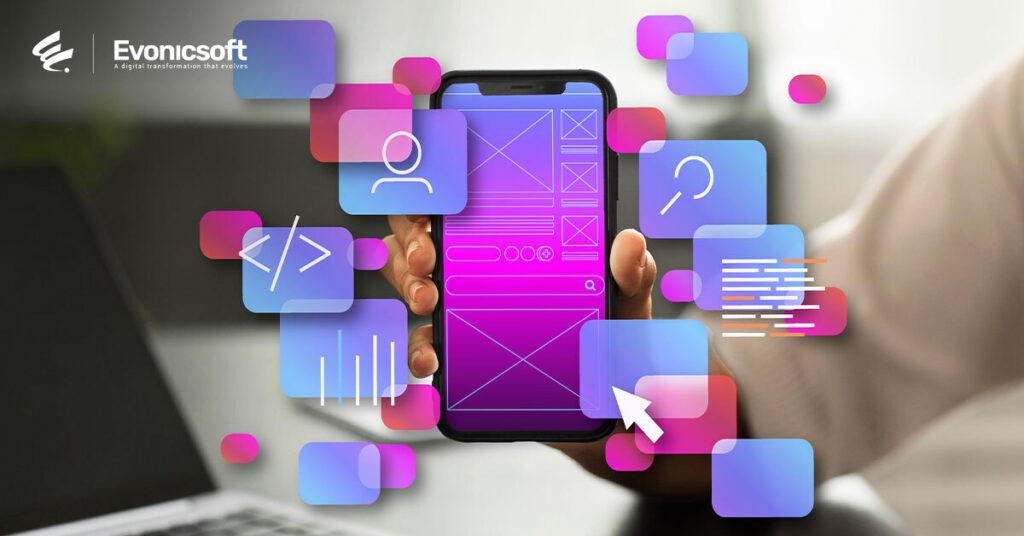
Mobile App Development: A Comprehensive Guide
- Sami Ul Hassan
- 14/09/2023
- Digital, Mobile Apps development
Introduction
In today’s digital era, mobile app development (mobile application development) has become an integral part of our lives. Smartphones are popular for communication, entertainment, productivity, and more, so the need for easy-to-use mobile apps keeps increasing.
Whether you’re a seasoned developer or a curious entrepreneur, understanding the fundamentals of mobile app development is essential. In this comprehensive guide, we’ll explore the key aspects of mobile app development. For all types of mobile devices, from ideation to deployment.
This guide is for both IOS developers and android developers.
Before you continue, please review One of the Best Mobile App Development Company in UAE
Chapter 1: The Foundation – Ideation and Understanding
Consider the process of developing a mobile application for smartphones and tablets as akin to preparing for a grand expedition. It’s super important to be really clear about what you want your app to achieve. This first step isn’t just about writing fancy code; it’s about setting a strong foundation for your app’s success.
It all starts with brainstorming, where you let your creative juices flow and explore exciting ideas. Then, you need to dig into some serious market research to understand what’s already out there and what users want.
However, the most crucial point is: identify the precise issue that your application will address. This step is a game-changer because it helps you steer your project in the right direction. To get started, you should ask questions to yourself like:
1. Who is your target audience?
2. What problem does your application solve?
3. What distinct features and advantages does your app offer?
4. How will your app stand out from the competition?
Chapter 2: Designing the User Experience
To create a great mobile app, it’s important to focus on both functionality and providing users with a fantastic experience. Imagine making a warm and welcoming home. It’s not just about the walls and roof, but also about how everything inside fits and moves smoothly. This is where the magic of user experience (UX) comes in.
In this phase, you’re making a rough plan and creating early versions of your app to see how everything works together. Imagine planning a dream house. You want each room in the perfect place and for people to move around easily.
So, you’ll make wireframes and prototypes, kind of like architectural blueprints for your app. The previews demonstrate the app’s appearance, user navigation, and overall design. The previews show how the app will look. They also show how users will navigate between sections.
Additionally, they demonstrate how the overall design will come together. Things to keep in mind during this stage include:
1. User Interface (UI) design
2. Navigation flow
3. User feedback and usability testing
4. Accessibility and responsiveness
Chapter 3: Choosing the Right Mobile App Development Approach
Mobile app development offers multiple avenues, including native, hybrid, and web apps. Each approach has its pros and cons and used for all type of mobile app for different operation system.
1. Native Apps: Developed specifically for one platform (iOS or Android), offering superior performance and user experience.
2. Hybrid Apps: Built using web technologies (HTML, CSS, JavaScript) and wrapped in a native shell, offering cross platform app compatibility.
3. Web Apps: Run within a mobile browser, providing broad accessibility but limited access to device features.
The choice of approach will depend on your project’s requirements, budget, and target audience. Point 2 & 3 are for all mobile platforms.
Chapter 4: Mobile App Development Tools and Technologies
Selecting the right development tools and technologies is crucial to building a robust mobile app. Key considerations include:
1. Programming languages (Swift, Kotlin, Java, JavaScript, etc.)
2. Integrated Development Environments (IDEs)
3. Frameworks and libraries
4. Version control systems (e.g., Git)
5. Backend development tools (for server-side components)
Chapter 5: Development and Testing
As we develop the app, we focus on creating its core by writing code. This is when the features of the app to form and become functional. It’s like building a finely-tuned machine with all its intricate parts working together.
Before welcoming your users, make sure everything runs smoothly. That’s where rigorous testing takes center stage. Think of it as quality control – you want to catch any glitches or hiccups that might disrupt the user experience.
It’s not just about creating an app; it’s about creating an app that’s a joy to use. So, we run through various testing stages to make sure everything’s shipshape:
1. Unit testing
2. Integration testing
3. User acceptance testing (UAT)
4. Beta testing with real users
5. Continuous testing and bug fixing
Chapter 6: Deployment and Distribution
When the time comes to unveil your app to the world, you’re stepping onto a new stage of the journey. It’s like opening night for a grand performance, and the spotlight is on your creation.
This phase is all about sharing your hard work and making it accessible to the eager users out there. So, what does this momentous occasion involve? Well, it’s not just about hitting the “publish” button. It’s a carefully orchestrated process that includes:
1. Apple app Store submission (for iOS) and Google Play Store submission (for Android)
2. Creating promotional materials and app descriptions
3. Improve app visibility with App Store Optimization (ASO).
4. Release management and version control
Chapter 7: Post-Launch and Maintenance
After launching your app, its journey doesn’t end; instead, you embark on a long voyage with many stages ahead.
Just as a ship needs a skilled captain to navigate through shifting seas. Same, your app requires ongoing maintenance, regular updates, and dedicated user support to stay on the path to success.
This post-launch phase is comparable to tending to a lush garden that requires care to thrive forever. The key tasks at this stage are akin to nurturing your creation, and they encompass:
1. Monitoring app performance and user feedback
2. Regularly updating the app to fix bugs and introduce new features
3. Analyzing user data to improve the app’s performance and user engagement
4. Scaling the app’s infrastructure as user base grows

Why you should higher Mobile App Development Agency?
Mobile app development is a dynamic and rewarding field that requires careful planning, creative thinking, and technical expertise. These steps can help you create a mobile app. It doesn’t matter if it’s for personal use, a startup, or an established business.
Keep your app current and successful by staying informed about industry trends and user preferences in the constantly changing mobile world. Remember, with dedication and the right approach, your mobile app can make a lasting impact on users worldwide.
Hiring a mobile app development agency can be a strategic decision with numerous benefits. Agencies have a skilled team of professionals who can build your app to high standards. They have diverse skills, including designers, developers, and quality assurance experts.
They are knowledgeable in assisting with the complex process of creating an app, from planning to launching. This saves your time and money.
Agencies know the latest trends and technologies, so your app stays competitive and current. Working with an agency can bring new and creative ideas that an in-house team may not have thought of.
Lastly, agencies can offer expandable, allowing you to flexibly adjust resources and development speed to meet your project’s evolving needs. Hiring a mobile app development company can simplify the development process. It can also improve the quality of your app and increase its chances of success in the competitive app industry.






